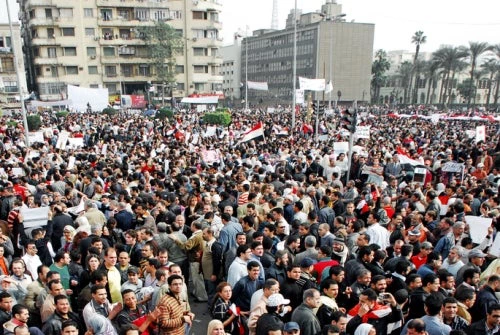 The ‘social contract’ is
an idea that dates back to the ancient Greeks, and refers to the implicit agreement among members of a society that defines their relationship with each other and the state. That relationship holds the key to unravelling the puzzle of the ‘Arab Spring.’
The ‘social contract’ is
an idea that dates back to the ancient Greeks, and refers to the implicit agreement among members of a society that defines their relationship with each other and the state. That relationship holds the key to unravelling the puzzle of the ‘Arab Spring.’
To development economists (like myself), the uprisings that started in Tunisia and spread to several countries in the Arab world in 2010-11 came as somewhat of a surprise. For the previous decade, almost all the indicators of economic well-being were strong and improving. GDP growth was substantial, at about 5 percent a year. Extreme poverty (people living on $1.25 a day) was low and declining. Conventional measures of inequality, such as the Gini coefficient, were lower than in other middle-income countries, and in some cases declining. In Egypt and Tunisia, the per-capita income of the bottom 40 percent was growing faster than the average. In terms of human development, the Middle East and North Africa region recorded the fastest decline in child mortality rates and the steepest increase in school attainment.
Yet, as various Gallup and World Values Surveys indicate, there was growing dissatisfaction in these societies, which erupted in revolutions in four countries and popular protests in several others. While much of the protests were about voice and political accountability, there is still a puzzle of how there could have been so much discontent in the face of seemingly strong and improving economic conditions. The solution lies in the nature of the social contract in these countries that, on the one hand, delivered the favorable indicators mentioned above, but on the other hand failed to meet the aspirations of the growing middle class, and especially its youth.
In almost all countries, governments provided free education and health; subsidies for food and, later, fuel; and jobs in the public sector with guaranteed benefits for life. The result was that human development progressed at a rapid pace; the economy grew thanks to oil-related rents and public investments; and the poor were protected with food subsidies. The outcomes were low and declining inequality, low poverty and, at least using the World Bank’s definition, shared prosperity.
On the other side of this social contract, however, were governments that were authoritarian, brooked very little dissent, and in some cases denied human rights to certain groups.
At the turn of the century, several aspects of this social contract were beginning to fray. First, because of significant fiscal deficits, the public sector could no longer be the “employer of first and last resort.” In fact, the public sector started retrenching. A generation of young people, who had diligently gone to school thinking they would get a public-sector job, found themselves unemployed. Worse, their skills were not suited to the private sector, which nevertheless was not growing rapidly enough to absorb them. The Middle East and North Africa found itself with the highest unemployment rate in the world, with the rates for young people and women nearly double the overall rate. Moreover, about 80 percent of the population believed that most jobs were based on connections rather than merit--adding to the frustration of newly-educated young population.
Secondly, it was becoming clear that lagging private sector growth was related to the autocratic nature of the regimes. In particular, friends and families of the autocrats benefited through monopoly rents in domestic industries, undermining export competitiveness and employment creation. For instance, the “Ben Ali firms” in Tunisia, while they were only 0.8 percent of industrial output, accounted for 21 percent of profits. These firms benefited from regulations that restricted foreign investment in sectors where they were involved—transport, banking and
telecommunications—which raised prices for inputs to the exporting sectors and made them less competitive globally. As a consequence, growth was insufficient to absorb the large number of young people entering the labor market each year.
Thirdly, the web of subsidies that were part of the social compact had become more of a burden than a benefit. Fuel subsidies in particular accrued mainly to the rich and resulted in an economic structure that favored capital- rather than labor-intensive industries. There is also evidence that, in Egypt, politically connected firms benefited disproportionately from fuel subsidies. The previously free education and health, while it delivered on basic education and health, was becoming increasingly ineffective at delivering quality. Teacher and doctor absenteeism in schools and clinics were common. A private sector emerged that made people pay for the same services to which they were entitled. As a woman in Egypt put it, “You can go to the private clinic and lose all your money, or go to the public clinic and lose your life.”
As a reflection of these difficulties with the social compact, citizens’ satisfaction with their governments was deteriorating, even when other economic indicators were looking promising. Resentment grew to the point where it erupted into widespread protests and in four countries, the autocratic leader was removed from office.
Understanding the Arab Spring paradox points us to the solution. It is clear that a new social contract is needed. Competition policy (a “level playing field”) should be enforced. Subsidies should be replaced with targeted cash transfers, which give poor citizens a choice of what goods to consume. And the public sector should be rationalized to perform those functions that government should perform, rather than simply be an employer of first or even last resort.


Join the Conversation